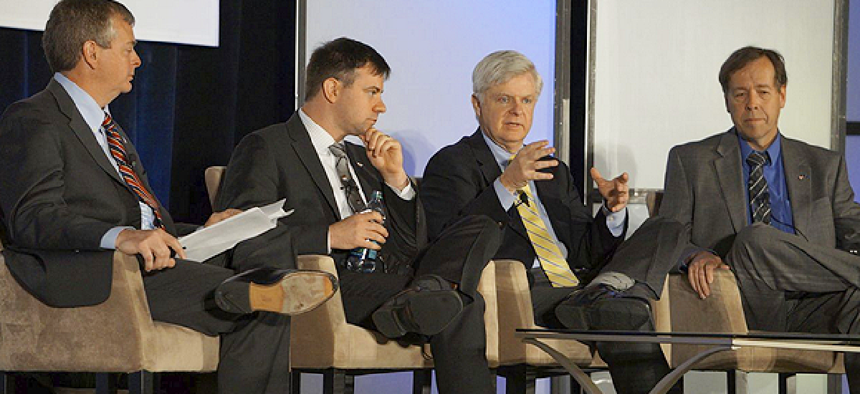'How do we adopt new technology? Painfully'

State IT leaders discuss the realities of implementing innovative tech.
In theory, all sorts of great technology is coming online for state government use: Unmanned aerial vehicles for agricultural surveys and building inspections. iBeacons for museums and other tourism centers. Even 3D printing for state labs and cryptocurrencies for online payments.
The reality, though, is a bit different.
State execs talk tech
Pictured above, left to right:
Chris Estes, State Chief Information Officer, North Carolina (moderator)
Eric Ellis, Chief Technology Officer, Department of Environment and Natural Resources, State of North Carolina & Director, North Carolina Innovation Center
Bill Oates, Commonwealth Chief Information Officer, Massachusetts
David Fletcher, Chief Technology Officer, Utah.
"Historically, new technology has not been adopted in our state," North Carolina Innovation Center Director Eric Ellis said. "It's been like beating your head against a wall. Fortunately, I have a thick skull."
Ellis, who is also the chief technology officer for North Carolina's Department of Environment and Natural Resources, was taking part in an April 28 panel discussion at the National Association of State CIOs mid-year conference in Alexandria, Va. Utah Chief Technology Officer David Fletcher and Massachusetts CIO Bill Oates were also part of the panel, and they reported similar experiences in their states.
"How do we adopt new technology?" Oates asked rhetorically? "Painfully."
The panelists were not defeatist, however -- merely candid about the structural and cultural hurdles they and their IT colleagues must clear to push new technologies.
"I've already started to see 3D printing impact our state," Ellis said. And while the government use cases for something like beacons may "seem small to start with," he added, "I believe they're going to have some of the greatest impact."
Fletcher, meanwhile, said big data and analytics could prove to be the most exciting opportunity. "The data that [states] have is voluminous," he said, "and broader than almost anybody else's."
Regardless of the new technology, though, all three speakers agreed that the trick boils down to pilot projects and good partners.
"We need to be creative about the type of applications we choose" to push government IT in new directions, Fletcher said. There needs to a clear way to show success -- "there's real power in understanding what the use cases are," he noted.
Agencies also need a path to launch that doesn't lock an them into a predefined IT solution before it's clear what the longer term needs will be. "Sometimes we may want to do a sole-source procurement" to move quickly," Fletcher said. "You can do that as a pilot," and keep options open for how to scale up after a limited test.
Pilots, Oates added, can also pre-empt security issues that might come with a full-blown project. "Putting some rings around" a pilot's project scope "lets us try things," he said.
Ellis, meanwhile stressed the importance of finding ways to partner and experiment with industry. North Carolina's Innovation Center, he said, has been critical -- though the physical space, even with millions of dollars worth of private sector "demo agreement" equipment available on-site, may be the least important part. The real value, he argued, was the culture of collaboration the center has instilled, along with the ready roster of possible partners.
Oates agreed that simply creating the mental space is half the battle. In Boston, he said, the city's New Urban Mechanics team has established itself as a go-to source for anyone seeking to try new things -- even as political leadership in the city has changed hands.
The great things about innovation offices like that, he said, is that they become "the front door for new ideas and innovations."
And state IT shops have no choice to but to push to find those entry points for innovation, Oates stressed. "We are still learning," he said. "But we are going to be hit by all these new technologies. ... These things are going to come faster than we expected."





